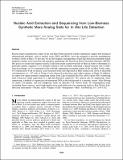| dc.contributor.author | Mojarro, Angel | |
| dc.contributor.author | Hachey, Jullie | |
| dc.contributor.author | Bailey, Ryan | |
| dc.contributor.author | Brown, Mark | |
| dc.contributor.author | Doebler, Robert | |
| dc.contributor.author | Ruvkun, Gary | |
| dc.contributor.author | Zuber, Maria | |
| dc.contributor.author | Carr, Christopher E. | |
| dc.date.accessioned | 2020-04-14T21:17:10Z | |
| dc.date.available | 2020-04-14T21:17:10Z | |
| dc.date.issued | 2019-11 | |
| dc.identifier.issn | 1531-1074 | |
| dc.identifier.uri | https://hdl.handle.net/1721.1/124639 | |
| dc.description.abstract | Recent studies regarding the origins of life and Mars-Earth meteorite transfer simulations suggest that biological informational polymers, such as nucleic acids (DNA and RNA), have the potential to provide unambiguous evidence of life on Mars. To this end, we are developing a metagenomics-based life-detection instrument which integrates nucleic acid extraction and nanopore sequencing: the Search for Extra-Terrestrial Genomes (SETG). Our goal is to isolate and sequence nucleic acids from extant or preserved life on Mars in order to determine if a particular genetic sequence (1) is distantly related to life on Earth, indicating a shared ancestry due to lithological exchange, or (2) is unrelated to life on Earth, suggesting convergent origins of life on Mars. In this study, we validate prior work on nucleic acid extraction from cells deposited in Mars analog soils down to microbial concentrations (i.e., 104 cells in 50 mg of soil) observed in the driest and coldest regions on Earth. In addition, we report low-input nanopore sequencing results from 2 pg of purified Bacillus subtilis spore DNA simulating ideal extraction yields equivalent to 1 ppb life-detection sensitivity. We achieve this by employing carrier sequencing, a method of sequencing sub-nanogram DNA in the background of a genomic carrier. After filtering of carrier, low-quality, and low-complexity reads we detected 5 B. subtilis reads, 18 contamination reads (including Homo sapiens), and 6 high-quality noise reads believed to be sequencing artifacts. | en_US |
| dc.language.iso | en | |
| dc.publisher | Mary Ann Liebert Inc | en_US |
| dc.relation.isversionof | http://dx.doi.org/10.1089/AST.2018.1929 | en_US |
| dc.rights | Article is made available in accordance with the publisher's policy and may be subject to US copyright law. Please refer to the publisher's site for terms of use. | en_US |
| dc.source | Mary Ann Liebert | en_US |
| dc.title | Nucleic Acid Extraction and Sequencing from Low-Biomass Synthetic Mars Analog Soils for In Situ Life Detection | en_US |
| dc.type | Article | en_US |
| dc.identifier.citation | Mojarro, Angel, et al. “Nucleic Acid Extraction and Sequencing from Low-Biomass Synthetic Mars Analog Soils for In Situ Life Detection.” Astrobiology 19, 9 (September 2019): 1139–52.© 2019 Angel Mojarro et al. | en_US |
| dc.contributor.department | Massachusetts Institute of Technology. Department of Earth, Atmospheric, and Planetary Sciences | en_US |
| dc.relation.journal | Astrobiology | en_US |
| dc.eprint.version | Final published version | en_US |
| dc.type.uri | http://purl.org/eprint/type/JournalArticle | en_US |
| eprint.status | http://purl.org/eprint/status/PeerReviewed | en_US |
| dc.date.updated | 2020-04-07T14:41:29Z | |
| dspace.date.submission | 2020-04-07T14:41:32Z | |
| mit.journal.volume | 19 | en_US |
| mit.journal.issue | 9 | en_US |
| mit.license | PUBLISHER_POLICY | |
| mit.metadata.status | Complete | |
